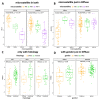Gene Regulatory Network Characterization of Gastric Cancer's Histological Subtypes: Distinctive Biological and Clinically Relevant Master Regulators
- PMID: 36230884
- PMCID: PMC9563962
- DOI: 10.3390/cancers14194961
Gene Regulatory Network Characterization of Gastric Cancer's Histological Subtypes: Distinctive Biological and Clinically Relevant Master Regulators
Abstract
Gastric cancer (GC) molecular heterogeneity represents a major determinant for clinical outcomes, and although new molecular classifications have been introduced, they are not easy to translate from bench to bedside. We explored the data from GC public databases by performing differential gene expression analysis (DEGs) and gene network reconstruction to identify master regulators (MRs), as well as a gene set analysis (GSA) to reveal their biological features. Moreover, we evaluated the association of MRs with clinicopathological parameters. According to the GSA, the Diffuse group was characterized by an epithelial-mesenchymal transition (EMT) and inflammatory response, while the Intestinal group was associated with a cell cycle and drug resistance pathways. In particular, the regulons of Diffuse MRs, such as Vgll3 and Ciita, overlapped with the EMT and interferon-gamma response, while the regulons Top2a and Foxm1 were shared with the cell cycle pathways in the Intestinal group. We also found a strict association between MR activity and several clinicopathological features, such as survival. Our approach led to the identification of genes and pathways differentially regulated in the Intestinal and Diffuse GC histotypes, highlighting biologically interesting MRs and subnetworks associated with clinical features and prognosis, suggesting putative actionable candidates.
Keywords: gastric cancer; gene expression profile; master regulator; molecular classification; prognostic biomarkers.
Conflict of interest statement
The authors declare no conflict of interest.
Figures




References
-
- Knight W.R., Allum W.H. Gastric tumours. Medicine. 2019;47:309–313. doi: 10.1016/j.mpmed.2019.02.002. - DOI
Grants and funding
LinkOut - more resources
Full Text Sources
Miscellaneous

